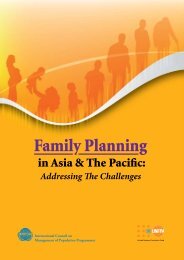SRH and HIV/AIDS Linkages at Policies, Programmes and Service ...
SRH and HIV/AIDS Linkages at Policies, Programmes and Service ...
SRH and HIV/AIDS Linkages at Policies, Programmes and Service ...
You also want an ePaper? Increase the reach of your titles
YUMPU automatically turns print PDFs into web optimized ePapers that Google loves.
BANGLADESHCAMBODIANEPALPHILIPPINESto know about <strong>HIV</strong> <strong>and</strong> have accessto inform<strong>at</strong>ion for <strong>SRH</strong> servicesincluding <strong>HIV</strong> inform<strong>at</strong>ion in theprogramme.Conclusion <strong>and</strong>Recommend<strong>at</strong>ions<strong>SRH</strong> <strong>and</strong> <strong>HIV</strong>/<strong>AIDS</strong> linkedprogrammes <strong>and</strong> services can work moreeffectively if they encompass notions ofintegr<strong>at</strong>ion, collabor<strong>at</strong>ion, coordin<strong>at</strong>ion<strong>and</strong> independent action. Furthermorethe linkage will also help to achievethe aim of RH <strong>and</strong> <strong>HIV</strong>/<strong>AIDS</strong> in thecountry because the majority of <strong>HIV</strong>infections are sexually transmitted orassoci<strong>at</strong>ed with pregnancy, childbirth<strong>and</strong> breastfeeding. The risk of <strong>HIV</strong>transmission <strong>and</strong> acquisition can beincreased by the presence of sexuallytransmitted infections. Again SR illhealth<strong>and</strong> <strong>HIV</strong> share root causes,including poverty, harmful gender/cultural norms, rights viol<strong>at</strong>ions,inequality <strong>and</strong> social marginalis<strong>at</strong>ion<strong>and</strong> criminalis<strong>at</strong>ion of the mostvulnerable popul<strong>at</strong>ions. There is also alack of availability <strong>and</strong> accessibility to<strong>SRH</strong> services <strong>and</strong> <strong>HIV</strong> counselling <strong>and</strong>testing, along with <strong>HIV</strong>/<strong>AIDS</strong> rel<strong>at</strong>edstigma <strong>and</strong> discrimin<strong>at</strong>ion prevalentin the society. Therefore linking <strong>SRH</strong>,<strong>HIV</strong> <strong>and</strong> rights interventions canimprove access to <strong>and</strong> uptake of services,provide better care in a more integr<strong>at</strong>edway, challenge the social factors th<strong>at</strong>influence <strong>SRH</strong> <strong>and</strong> <strong>HIV</strong>, reduce stigma<strong>and</strong> strengthen rights-based policies<strong>and</strong> laws.There are several linkages between <strong>HIV</strong><strong>and</strong> <strong>SRH</strong> services th<strong>at</strong> will virtuallyelimin<strong>at</strong>e mother-to-child <strong>HIV</strong>transmission, provide an ideal pl<strong>at</strong>formto deliver the entire recommendedminimum package of anten<strong>at</strong>al,m<strong>at</strong>ernal, child health <strong>and</strong> reproductivehealth services.This would ensure th<strong>at</strong> pregnant womenare not only offered <strong>HIV</strong> screening,but th<strong>at</strong> they <strong>and</strong> their partnersare also offered services to prevent<strong>HIV</strong> <strong>and</strong> other sexually transmittedinfections, unwanted pregnancies <strong>and</strong>sexual violence. PMTCT services toANC services could be another majorbreakthrough in the area of linkingthe two programmes. A concreteinstitutional commitment is essentialto <strong>HIV</strong>/<strong>AIDS</strong> including <strong>SRH</strong> issues.Here are some recommend<strong>at</strong>ions th<strong>at</strong>will help to overcome the challenges:There should be meaningfulparticip<strong>at</strong>ion of differentstakeholders, through analysis of thefindings, development of a commonvision, identific<strong>at</strong>ion of acceptablestr<strong>at</strong>egies <strong>and</strong> also programmemanagement.There is a need to develop anapproach th<strong>at</strong> will be more peoplecenteredwith a multi-sectoralplanning <strong>and</strong> decision makingprocess th<strong>at</strong> increases access toresources.Scale up behavioural change activities<strong>and</strong> health promotion interventionsfor high-risk behaviours <strong>and</strong>vulnerable groups, particularly IDUs<strong>and</strong> sex workers.Exp<strong>and</strong> advocacy <strong>and</strong> awarenessamong the general popul<strong>at</strong>ionthrough multi-sectoral agencies.32














